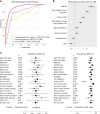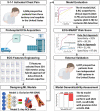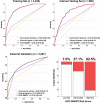Machine learning for ECG diagnosis and risk stratification of occlusion myocardial infarction
- PMID: 37386246
- PMCID: PMC10353937
- DOI: 10.1038/s41591-023-02396-3
Machine learning for ECG diagnosis and risk stratification of occlusion myocardial infarction
Abstract
Patients with occlusion myocardial infarction (OMI) and no ST-elevation on presenting electrocardiogram (ECG) are increasing in numbers. These patients have a poor prognosis and would benefit from immediate reperfusion therapy, but, currently, there are no accurate tools to identify them during initial triage. Here we report, to our knowledge, the first observational cohort study to develop machine learning models for the ECG diagnosis of OMI. Using 7,313 consecutive patients from multiple clinical sites, we derived and externally validated an intelligent model that outperformed practicing clinicians and other widely used commercial interpretation systems, substantially boosting both precision and sensitivity. Our derived OMI risk score provided enhanced rule-in and rule-out accuracy relevant to routine care, and, when combined with the clinical judgment of trained emergency personnel, it helped correctly reclassify one in three patients with chest pain. ECG features driving our models were validated by clinical experts, providing plausible mechanistic links to myocardial injury.
© 2023. The Author(s).
Conflict of interest statement
US Patent 10820822; owner: University of Pittsburgh; inventors: S.S.A.-Z., E.S. and C.W.C. This patent describes methods and systems for identifying increased likelihood of non-ST elevation myocardial infarction (NSTEMI) in a patient based on ECG data. This patent is not under any licensing or commercial agreement whatsoever. The remaining authors declare no competing interests.
Figures













Update of
-
Machine Learning for the ECG Diagnosis and Risk Stratification of Occlusion Myocardial Infarction at First Medical Contact.Res Sq [Preprint]. 2023 Jan 30:rs.3.rs-2510930. doi: 10.21203/rs.3.rs-2510930/v1. Res Sq. 2023. Update in: Nat Med. 2023 Jul;29(7):1804-1813. doi: 10.1038/s41591-023-02396-3. PMID: 36778371 Free PMC article. Updated. Preprint.
References
Publication types
MeSH terms
Grants and funding
LinkOut - more resources
Full Text Sources
Medical

